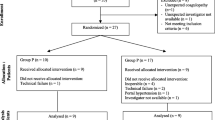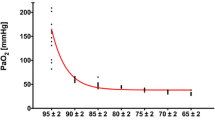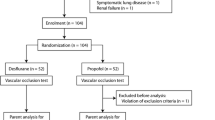Abstract
Purpose
Effects of sevoflurane and halothane anesthesia on liver circulation and oxygen metabolism during hepatolobectomy were investigated in the dog, with the aim of choosing a better anesthetic for hepatic resection.
Methods
Sixteen mongrel dogs were randomly divided into two groups with eight in each. Electromagnetic flowmeters were used to measure hepatic arterial and portal venous blood flows (1) before the inhalation of each anesthetic (base line); (2) 1 h after the start of inhalation of 1.5 minimum alveolar concentration (MAC) anesthetic; (3) 1 h after hepatolobectomy with the same MAC of anesthesia; and (4) 2 h after the discontinuation of anesthesia. Measurements of systemic hemodynamics, blood gas tensions, plasma enzyme leaks and arterial ketone body ratio were made at the same time.
Results
Sevoflurane maintained hepatic arterial blood flow better than halothane anesthesia, both before and after hepatolobectomy. Hepatic arterial vascular resistance increased in the halothane group but did not change in the sevoflurane group after hepatolobectomy. No significant difference was found in oxygen metabolism and arterial ketone body ratio between two groups. Serum enzyme leakage was less in the sevoflurane group.
Conclusion
Sevoflurane has less adverse effects on liver circulation, especially hepatic arterial blood flow, and hepatic function than halothane in the case of hepatolobectomy.
Similar content being viewed by others
References
Andreen M, Irestedt L, Zetterstrom B (1977) The different responses of the hepatic arterial bed to hypovolaemia and to halothane anesthesia. Acta Anaesth Scand 21:457–469
Hughes RL, Campbell D, Fitch W (1980) Effects of enflurane and halothane on liver blood flow and oxygen consumption in the greyhound. Br J Anaesth 52:1079–1086
Gelman S, Fowler KC, Smith LR (1984) Liver circulation and function during isoflurane and halothane anesthesia. Anesthesiology 61:726–730
Gelman S (1987) General anesthesia and hepatic circulation. Can J Physiol 65:1762–1779
Frink EJ, Brown BRJ (1993) Sevoflurane. Bailliere's Clin Anesthesiol 7:899–913
Andreen M (1982) Inhalation versus intravenous anesthesia. Effects on the hepatic and splanchnic circulation. Acta Anaesthesiol Scand 75 (suppl):25–31
Thomson IA, Fitch W, Hughes RL, Campbell D (1983) Effect of increased concentration of carbon dioxide during halothane anesthesia on liver blood flow and hepatic oxygen consumption. Br J Anaesth 55:1231–1237
Merin RG, Bernard JM, Doursout MF, Cohen M, Chelly JE (1991) Comparison of the effects of isoflurane and desflurane on cardiovascular dynamics and regional blood flow in chronically instrumented dogs. Anesthesiology 74:568–574
Frink EJ, Morgan SE, Coetzee A, Conzen PF, Brown BR (1992) The effects of sevoflurane, halothane, enflurane, and isoflurane on hepatic blood flow and oxygenation in chronically instrumented greyhound dogs. Anesthesiology 76:85–90
Bernard JM, Doursout MF, Wounters P, Hartley CJ, Merin RG, Chelly JE (1992) Effects of sevoflurane and isoflurane on hepatic circulation in the chronically instrumented dogs. Anesthesiology 77:541–545
Richardson PDI, Withrington P (1975) Liver blood flow. I. Intrinsic and nervous control of liver blood flow. Gastroenterology 81:159–173
De Jong RH, Eger EI II (1975) MAC expanded: AD50 and AD95 values of common inhalation anesthetics in man. Anesthesiology 42:384–389
Thomson IA, Fitch W, Hughes RL, Campbell D, Watson R (1986) Effects of certain i.v. anaesthetics on liver blood flow and hepatic oxygen consumption in the greyhound. Br J Anaesth 58:69–80
Lautt WW (1985) Mechanism and role of intrinsic regulation of hepatic arterial blood flow: hepatic arterial buffer response. Am J Physiol 249:G549-G556
Sigmon DH, Florentino-Pineda I, Van Dyke RA, Beierwaltes WH (1995) Halothane impairs the hemodynamic influence of endothelium-derived nitric oxide. Anesthesiology 82:135–143
Gelman S, Van Dyke RA (1988) Mechanism of halothane-induced hepatotoxicity: another step on a long path. Anesthesiology 68:479–482
Gelman S (1976) Disturbances in heaptic blood flow during anesthesia and surgery. Arch Surg 111:881–883
Author information
Authors and Affiliations
About this article
Cite this article
Yu, Bw., Matsumoto, N. Effects of sevoflurane and halothane anesthesia on liver circulation and oxygen metabolism in the dog during hepatolobectomy. J Anesth 11, 213–218 (1997). https://doi.org/10.1007/BF02480040
Received:
Accepted:
Issue Date:
DOI: https://doi.org/10.1007/BF02480040




